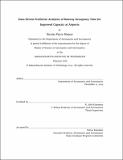Data-driven predictive analytics of runway occupancy time for improved capacity at airports
Author(s)
Meijers, Nicolas Pierre.
Download1199073455-MIT.pdf (9.292Mb)
Other Contributors
Massachusetts Institute of Technology. Department of Aeronautics and Astronautics.
Advisor
R. John Hansman.
Terms of use
Metadata
Show full item recordAbstract
Runway Occupancy Time (ROT) is a major constraint for runway throughput. An incentive exists to reduce ROT at capacity-constrained airports and accommodate additional air transportation demand. The availability of a large quantity of surveillance data on landing operations at major US airports provides an opportunity to understand the factors driving ROT and develop reliable methods to reduce ROT by optimizing runway exit systems. This thesis presents a data-driven approach to understanding the factors influencing Runway Occupancy Time (ROT). Airport Surface Detection Equipment - model X (ASDE-X) data, from the ³6 largest airports in the US, provided detailed flight track data that were combined with airport and weather data to analyze ROT. The relative importance of different factors driving ROT was first assessed using a random-forest algorithm. The dominant factors identified were then studied individually to obtain a better understanding of ROT behavior. Based on this improved understanding of ROT, predictive models of ROT were designed and presented in this thesis. Using a two-step process, these models are able to stochastically predict ROT for aircraft landing in specific conditions on a runway characterized by its exit system. First, a Recurrent Neural-Network model predicts the probability of use of each available runway exit. Second, a set of Feed-Forward Neural-Networks predicts the average and variance of ROT that would be observed if the aircraft was vacating the runway using each exit. These two predictions were combined to obtain a predicted gaussian-mixture distribution of ROT for the landing aircraft. These models were used to predict the distribution of ROT of a given runway by making stochastic predictions of ROT for thousands of flights. The impact on ROT of different changes to the exit system of the runways at Keflavík airport in Iceland was assessed using these models. Keflavík airport currently has a poor Runway Occupancy Time performance with an 8os average ROT. The predictive models were used to identify the location of new exits providing the best ROT reduction. According to the models, modifications to the exit system would potentially provide up to 23s of reduction in average ROT observed during peak-hour operations.
Description
This electronic version was submitted by the student author. The certified thesis is available in the Institute Archives and Special Collections. Thesis: S.M., Massachusetts Institute of Technology, Department of Aeronautics and Astronautics, 2020 Cataloged from student-submitted PDF of thesis. "February 2020." Includes bibliographical references (pages 105-107).
Date issued
2020Department
Massachusetts Institute of Technology. Department of Aeronautics and AstronauticsPublisher
Massachusetts Institute of Technology
Keywords
Aeronautics and Astronautics.